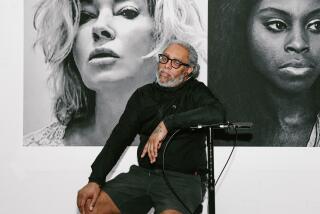What Michael Jackson’s ‘Thriller’ has to do with the vivid new album from Beck
Standing on the 12th floor of the Capitol Records tower in Hollywood, Beck gazed through a south-facing window and pointed toward a neighborhood straddling nearby Sunset Boulevard.
“We lived over there when I was a kid, and it was all bungalow houses for six or seven blocks in every direction,” the singer said. Today the family homes are long gone, of course, replaced by office structures and densely packed apartment buildings; construction cranes dotted the view from Capitol on a recent afternoon, a forecast of still more development to come.
Yet Beck wasn’t surveying the transformation with an old-timer’s scorn. His tone was philosophical as he imagined a future “when you’ll tell a young person that you used to live in a house,” as he put it with a gentle laugh.
“They’ll be like, ‘They used to have houses here?’”
For nearly 25 years, Beck has been keeping himself open to change, veering among musical styles — from the junkyard hip-hop of “Loser” to the swinging soul-funk of “Sexx Laws” to the crisp ’60s rock of “Gamma Ray” — with the dogged curiosity of someone convinced his next discovery could be his best.
Now, the 47-year-old has undertaken what might be his most surprising shift yet. As the follow-up to 2014’s “Morning Phase” — a lushly arranged collection of orchestral folk tunes that won the Grammy Award for album of the year — Beck teamed with producer and songwriter Greg Kurstin to create “Colors,” which trades moody, slow-moving acoustic guitars for ecstatic pop melodies and slick dance beats.
Released last week, “Colors” also feels like an unabashed stab at mainstream currency by an artist who not long ago was reaching for something more like timelessness.
“I think we treated this album like it was one that a lot of people would hopefully like,” said Kurstin, known for his blockbuster collaborations with Adele (“Hello”) and Kelly Clarkson (“Stronger”). “It seemed like it might not be too weird to get played on the radio.”

In that regard the men have succeeded, with two tracks from “Colors” — the throbbing “Wow” and the disco-grungy “Dreams” — peaking inside the top 10 of Billboard’s alternative chart. “Wow” also soundtracked a widely seen car commercial, one of several high-profile licensing deals Beck has struck for the new album, which he’ll celebrate with a sold-out show Wednesday night at the Ford Theatre.
Yet “Colors” doesn’t feel as craven as all that might suggest. Its textures are vivid and ear-grabbing, its emotions powerfully expressed; the album is functioning commercially in the same way that music by Beyoncé or Chance the Rapper functions commercially — as a means of being heard, of taking part in the larger cultural conversation.
“I was thinking about connection and possibility and freedom,” Beck said, adding that he was inspired by a sense he often gets about two-thirds of the way through a concert, when audience members relax their natural inhibitions and “it feels like anything could happen.”
“Who are we when we get in that space?” he mused. “And what would happen if there were songs that could help unlock it?”
Beck came to “Colors” after spending “a bunch of years” focusing on projects he described as “experimental and angular and obtuse and a little harder to access.” Before “Morning Phase,” which openly echoed the rootsy arrangements of his 2002 album “Sea Change,” he’d produced brainy indie-rock albums by Stephen Malkmus of Pavement and Sonic Youth’s Thurston Moore and put out “Song Reader,” a book of sheet music.
“So, after that, I just wanted to write some really simple songs with melodies,” he said, dressed in a flannel shirt, his blond hair boyishly mussed, as he reclined in a chair in a small mixing suite at Capitol.
He did a bit of recording with Pharrell Williams, whose album “Girl” was among those “Morning Phase” beat at the Grammys in 2015. (Another was Beyoncé’s self-titled record, which led Kanye West to famously leap onstage and pretend to interrupt Beck’s acceptance speech.) He also tried writing with Paul Epworth and a handful of other studio wizards.
But nothing clicked like the stuff he did with Kurstin, whom he’d met years before when the producer played keyboards on Beck’s tour behind “Sea Change.”
Working together at Kurstin’s studio in Los Angeles, the two would start songs on piano, trying to make them as sturdy — and as catchy — as possible. “It was like our own little Brill Building,” Beck said, referring to the community of pop songwriters who wrote in offices at that New York landmark in the 1950s and ’60s.
Kurstin added that quality control was high. “We’d throw out whole verses and choruses if they weren’t right,” he said, a method Kurstin was accustomed to but that Beck was embracing fully for the first time.

Once the basic tunes were in shape, the men set about carefully arranging them for maximum impact; Beck said their goal was an album as thoroughly considered as Michael Jackson’s “Thriller” or “Pet Sounds” by the Beach Boys — one for which every idea was attempted, every option explored.
You make records for long enough, he said, “and you know what your default settings are. Like, the first song we did was ‘Dear Life,’” a funky rock number built on fuzzy electric guitar and a rolling saloon piano lick. “‘OK, that’s the default. We can make a whole record like that in a couple weeks. Now let’s go get lost and try to find something else.’”
What they found were the thrusting rhythms in “Square One,” the blissed-out synths in “Seventh Heaven” and the sliced-and-diced vocal layering in the title track — techniques that seem new for Beck even as they push the music toward the sound of modern Top 40 pop.
Or at least his own version of that sound, Beck was quick to point out.
“With most things these days that aren’t rock bands — actually, with the rock bands too — everything’s in the box,” he said, meaning the instrumental voices are simulated or sequenced by machines. “You’re hearing sounds that have never been recorded through the real world, so there’s no air in them.”
“Colors,” in contrast, consists of hand-played performances that have been polished to a gleam.
“It’s really tight, but it’s breathing,” Beck said. “That was the trick.”
Twitter: @mikaelwood
ALSO
Why losing Tom Petty feels like losing a piece of ourselves
What ‘Springsteen on Broadway’ gets wrong about the Boss’ job
Pink on her new album, Billy Joel and why she’s over pop-star feuds
More to Read
The biggest entertainment stories
Get our big stories about Hollywood, film, television, music, arts, culture and more right in your inbox as soon as they publish.
You may occasionally receive promotional content from the Los Angeles Times.







